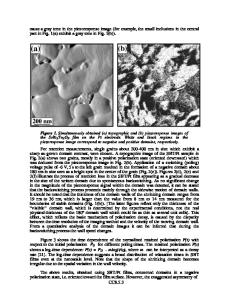Influence of Ta content on the physical properties of SrBi 2 Ta 2 O 9 ferroelectric thin films
- PDF / 602,389 Bytes
- 10 Pages / 585 x 783 pts Page_size
- 85 Downloads / 386 Views
Ching-Chich Leu Department of Chemical and Materials Engineering, National University of Kaohsiung, Kaohsiung 811, Taiwan, Republic of China
Chao-Hsin Chien Department of Electronics Engineering, National Chiao Tung University, Hsinchu 30050, Taiwan, Republic of China
Chen-Ti Hua) Department of Materials Science and Engineering, National Tsing Hua University, Hsinchu 30013, Taiwan, Republic of China (Received 17 March 2006; accepted 16 August 2006)
We have investigated the effect that the Ta content has on the ferroelectric properties of strontium bismuth tantalate (SBT) thin films synthesized using metalorganic decomposition (MOD) and spin coating techniques. The physical properties of these SBT samples were strongly dependent upon the Ta ratio. Polarization measurements revealed that Ta-deficient SBT exhibited a relatively low coercive field (2Ec ∼ 87 kV/cm) and a high remanent polarization (2Pr ∼ 15 C/cm2). The value of 2Pr decreased as the Ta ratio in SBT increased. The improved ferroelectric properties of the Ta-deficient SBT samples may have resulted from the uniformly well-grown bismuth-layered-structured (BLS) phases of the films and their highly preferential orientation along the a and b axes. We suggest that the incorporation of Ta vacancies plays an important role in enhancing the crystallinities and microstructures of Ta-deficient SBT films.
I. INTRODUCTION
Although strontium bismuth tantalate (SrBi2Ta2O9, SBT) is one of the most promising materials for application in nonvolatile random access memories (it displays several excellent ferroelectric properties, such as a low leakage current, low operating voltage, and fatigue endurance for up to 1012 switching cycles),1 its high crystallization temperature (>750 °C), which is obviously incompatible with conventional very large scale integrated (VLSI) processes, and the relatively low remanent polarization of SBT thin films remain major obstacles for its deployment. Ferroelectric SBT thin films have been grown using many techniques, including metalorganic decomposition (MOD),2 pulsed laser deposition (PLD),3 and metalorganic chemical vapor deposition (MOCVD).4 The MOD method in particular offers a number of advantages, such
a)
Address all correspondence to this author. e-mail: [email protected] DOI: 10.1557/JMR.2006.0383 3124 J. Mater. Res., Vol. 21, No. 12, Dec 2006 http://journals.cambridge.org Downloaded: 17 Mar 2015
as good homogeneity, long shelf-life, precise control over the composition, low cost, and simplicity.5 It is well known that the ferroelectric properties of SBT thin films along the a and b axes are much better than those along the c axis.6 Thus, the texture of SBT thin film is an important factor for determining its electrical properties. MOD is not, however, an effective method when attempting to control the crystalline orientation. A number of techniques are used to manipulate the film orientation during wet chemical depositions such as the MOD and sol-gel methods, for example, utilizing the appropriate substrates with either a
Data Loading...











